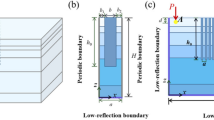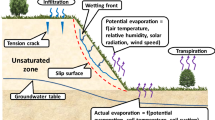Abstract
Based on inversion of the horizontal-to-vertical spectral ratio of microtremors (H/V), the empirical H/V spectrum of surface waves propagating on a layered half-space was studied and the effects of soil layers on fundamental and higher peak frequencies were considered. Using the Nakamura H/V spectral method and comparing it with the analytical site-to-reference (RF) method, inverse analysis is performed. These procedures were carried out at several stations around Iran. The results indicate that the transfer function of upward propagation is equal to the downward transfer functions, and is independent of the direction of wave propagation. Furthermore, the resonant peaks depend on the sedimentary cover depth; the next peaks in the H/V spectrum (the peaks after the resonant peak) were generated either in the higher mode of resonant amplification in thick layers and/or from wave interference, subsurface topography and different impedance between two adjacent thin layers as well as resonance amplification. In addition, the analysis indicates that fewer deep sedimentary layers instead of multi-layers do not lead to variation in transfer functions. In deep-deposit layers, the soil layer difference can amplify the amplitude, and does not create a new peak in H/V spectral ratio.










Similar content being viewed by others
References
Arai H, Tokimatsu K (2004) S-wave velocity profiling by inversion of microtremor H/V spectrum. Bull Seismol Soc Am 94(1):53–63
Bonnefoy-Claudet S, Cotton F, Bard P-Y (2006) The nature of noise wavefield and its applications for site effects studies: a literature review. Earth Sci Rev 79(3–4):205–227
Foti S (2005) Surface wave testing for geotechnical characterization. In: Surface waves in geomechanics: direct and inverse modelling for soils and rocks, CISM Series. Springer, Wien, p 47–71
Horike M, Zhao B, Kawase H (2001) Comparison of site response characteristics inferred from microtremors and earthquake shear wave. Bull Seismol Soc Am 91:1526–1536
Kazemeini M, Haghshenas E, Kamalian M (2015) Experimental evaluation of seismic site response over and nearby underground cavities (study of subway tunnel in city of Karaj, Iran). Iran J Sci Technol Trans Civ Eng 39:319–332
Kramer SL (1996) Geotechnical earthquake. Engineering, vol 653. Prentice Hall, New Jersey
Lachet C, Bard P-Y (1994) Numerical and theoretical investigations on the possibilities and limitations of Nakamura’s technique. J Phys Earth 42:377–397
Lebrun B, Duval A-M, Bard P-Y, Monge O, Bour M, Vidal S, Fabriol H (2004) Seismic microzonation: a comparison between geotechnical and seismological approaches in Pointe-à-Pitre (FrenchWest Indies). Bull Earthq Eng 2:27–50
Malischewsky PG, Scherbaum F (2004) Love’s formula and H/V ratio (ellipticity) of Rayleigh waves. Wave Motion 40(1):57–67
Malischewsky P et al (2010) Some new theoretical considerations about the ellipticity of Rayleigh waves in the light of site-effect studies in Israel and Mexico. Geofísica Int 49(3):141–152
Mejia LH, Dawson EM (2006) Earthquake deconvolution for FLAC. In: Hart, Varona (eds.) 4th International FLAC symposium on numerical modeling in geomechanics, p 4–10
Mokhberi M et al (2013) Experimental evaluation of the H/V spectral ratio capabilities in estimating the subsurface layer characteristics. Iran J Sci Technol Trans Civ Eng 37:457–468
Mucciarelli M (1998) Reliability and applicability of Nakamura’s technique using microtremors: an experimental approach. J Earthq Eng 2(4):1–14
Oubaiche EH, Chatelain JL, Hellel M, Wathelet M, Machane D, Bensalem R, Bouguern A (2016) The relationship between ambient vibration H/V and SH transfer function: some experimental results. Seismol Res Lett 87(5):1112–1119
Parolai S (2009) Determination of dispersive phase velocities by complex seismic trace analysis of surface waves (CASW). Soil Dyn Earthq Eng 29(3):517–524
Parolai S, Bindi D, Augliera P (2000) Application of the Generalized Inversion Technique (GIT) to a microzonation study: numerical simulations and comparison with different site estimation techniques. Bull Seismol Soc Am 90(2):286–297
Sgarlato G, Lombardo G, Rigano R (2011) Evaluation of seismic site response nearby underground cavities using earthquake and ambient noise recordings: a case study in Catania area, Italy. Eng Geol 122(3–4):281–291
Socco LV, Boiero D (2008) Improved Monte Carlo inversion of surface wave data. Geophys Prospect 56(3):357–371
Tarantola A (2005) Inverse problem theory and methods for model parameter estimation. SIAM, Philadelphia
Tokimatsu K, Shinzawa K, Kuwayama S (1992) Use of short-period microtremors for V S profiling. J Geotech Eng 118(10):1544–1558
Tuan TT et al (2016) Approximate formula of peak frequency of H/V ratio curve in multilayered model and its use in H/V ratio technique. Pure Appl Geophys 173(2):487–498
Yamanaka H, Takemura M, Ishida H, Niwa M (1994) Characteristics of long-period microtremors and their applicability in exploration of deep sedimentary layers. Bull Seismol Soc Am 84(6):1831–1841
Yasuia Y, Noguchib T (2004) Soil profile confirmation through microtremor observation. In: Proceedings third UJNR workshop on soil-structure interaction, Menlo Park, California
Yasuia Y and Noguchib T (2009) Soil profile confirmation through microtremor observation. In: Proceedings third UJNR workshop on soil-structure interaction, Menlo Park, California
Author information
Authors and Affiliations
Corresponding author
Rights and permissions
About this article
Cite this article
Davoodi, M., Mokhberi, M., Haghshenas, E. et al. Estimation of the Thickness of Multi-layer Soils from the Higher Peak of H/V Spectral Ratio. Iran J Sci Technol Trans Civ Eng 43, 157–166 (2019). https://doi.org/10.1007/s40996-018-0124-1
Received:
Accepted:
Published:
Issue Date:
DOI: https://doi.org/10.1007/s40996-018-0124-1




